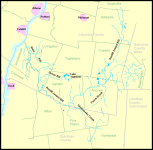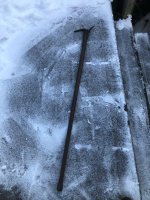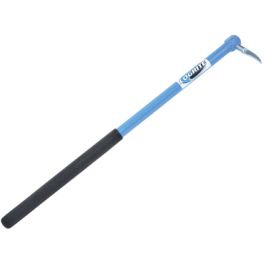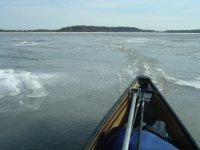About a week ago my lake had enough open water to go out for a paddle. I could only paddle for a few hundred yards before hitting ice. In order to reach more open water I would have to bust through ice near shore that was too thin to support the boat. The pole was the tool to do that.
The next obstacle I encountered was ice too thick to bust through. I used a combination of the pole and an ice hook to get from the weak ice to the strong ice. I pushed the boat as far onto the solid ice as I could. Then I pulled myself far enough up on solid ice to get out at the stern to push the boat to the next open water. I used the hook for that.
When you push your boat across the ice you need to support some of your weight on the gunnels if the thickness is questionable.
Once I got to the open lead and the bow was near the edge of the ice I got back in the boat. Then I used the straight point on the ice hook to push the boat into the water. Sometimes the solid ice crossings were short enough that I could get up enough speed with the pole to slide across it. It is an exciting feeling when your hull slides from the ice to the water, especially when standing.
I was able to cover about 1.5 miles one way which made it quite worthwhile for me. Without the pole or hook my paddling would have been limited and nowhere near as fun.
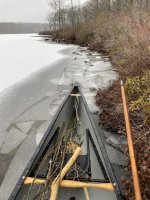
This is where the pole is needed.

You need a hook to get up on “safe” ice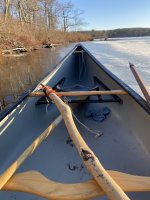
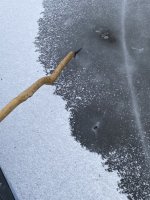 you can use the hook as a probe to check ice thickness. I was surprised to find the ice to be not much more than an inch thick and still supported me. That’s with weight on the gunnels.
you can use the hook as a probe to check ice thickness. I was surprised to find the ice to be not much more than an inch thick and still supported me. That’s with weight on the gunnels.
It was great fun and a great way to extend the paddling season.
The next obstacle I encountered was ice too thick to bust through. I used a combination of the pole and an ice hook to get from the weak ice to the strong ice. I pushed the boat as far onto the solid ice as I could. Then I pulled myself far enough up on solid ice to get out at the stern to push the boat to the next open water. I used the hook for that.
When you push your boat across the ice you need to support some of your weight on the gunnels if the thickness is questionable.
Once I got to the open lead and the bow was near the edge of the ice I got back in the boat. Then I used the straight point on the ice hook to push the boat into the water. Sometimes the solid ice crossings were short enough that I could get up enough speed with the pole to slide across it. It is an exciting feeling when your hull slides from the ice to the water, especially when standing.
I was able to cover about 1.5 miles one way which made it quite worthwhile for me. Without the pole or hook my paddling would have been limited and nowhere near as fun.

This is where the pole is needed.

You need a hook to get up on “safe” ice

 you can use the hook as a probe to check ice thickness. I was surprised to find the ice to be not much more than an inch thick and still supported me. That’s with weight on the gunnels.
you can use the hook as a probe to check ice thickness. I was surprised to find the ice to be not much more than an inch thick and still supported me. That’s with weight on the gunnels.It was great fun and a great way to extend the paddling season.

